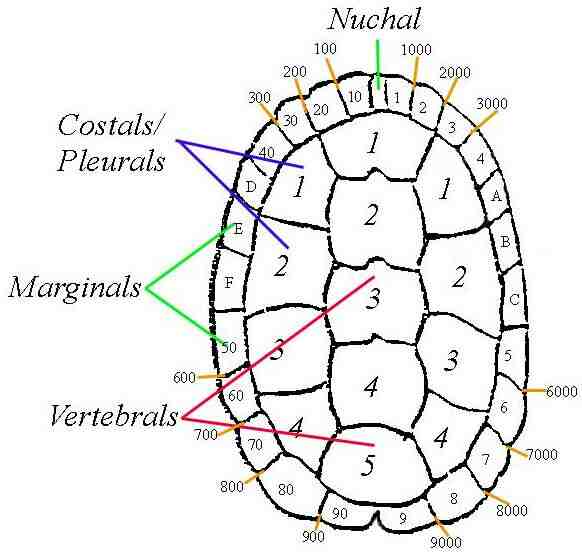|
Terrapin Identification: The numbering procedure we use was adapted and modified over the years from one listed in the distant annals of Wellfleet Bay as the “Schwartz” system. Modifications occurred when we passed various milestones, such as the first 100 turtles and then the first 1000 terrapins, to accommodate the anticipated population size. Each terrapin is uniquely and individually marked, so that we can follow its life history. We use the same numbering series for all Outer Cape terrapins found on the Cape Cod Bay side; we use the same system, but a separate series, for turtles on the Atlantic Ocean side of the Outer Cape. The reason: while turtles may migrate between bayside estuaries (such as the recent travels of Terrapin 220 from Wellfleet to Eastham), the movement of terrapins from bayside to ocean side (or vice versa) around the tip of Provincetown is for all practical purposes impossible. Should such an anomalous event occur, it would still be fairly easy to recognize based on size and growth patterns of the duplicately marked turtles.
The 12 marginal scutes on the right side of the carapace are given single digits values. The 12 marginals on the left side are assigned tens. We place these marks in the middle of the marginal scute. Except for rare circumstance, we do not use the marginals A, B, C or D, E, F that lie immediately over the bridge. Marks in these locations are not easy to make and tend to obscure with time. When practical, we normally place a double mark in the value farthest distant from the front end. These double notches are obviously unnatural and provide an immediate cue to researchers that the turtle is marked (as opposed to naturally nicked). Hundred values fall on the sutures between the left marginals; thousands on the right sutures. We do not use 400 or 500 nor do we intend to use 4000 or 5000, again because these values are difficult to mark and tend to obscure too quickly. So, for a terrapin marked 888, we would place a notch in the “800” slot in the suture between the “70” and “80” marginals. We would place a notch in the center of the “80” marginal scute and a double notch in the center of the “8” marginal. On the data sheet, we would record these marks as follows. And, of course, we take a digital image of the marked carapace for permanent record.
Some turtles carry anomalies which may confused numbering. Terrapins are found with 13 marginal scutes on either the left side or the right side or both. We usually describe these turtles as having “split” 9 or 90 marginals, or both. In these cases the “split marginal” is considered as a single value, and the data sheet would be marked with a “split” or line running through the 9 and/or 90 marginal to indicate the anomaly. So, if we were marking a turtle with “split 9 & 90 marginals” as number 888, the notches would appear as described in the diagram below.
We use the same numbering system for eastern box turtles, painted turtles, and spotted turtles. |


